Partial Solar Eclipse at New Jersey
August 24, 2017
My first experience with a
solar eclipse was on July 20, 1963, when the path of an eclipse passed through
Canada and
Maine, resulting in a significant
occultation at my
childhood home near 43.12298
North Latitude, 75.20335
West Longitude. I've never experienced a
total solar eclipse. For the
recent eclipse of August 21, 2017, I was determined to make some
scientific measurements at my far-from-ideal location at 40.8768 North Latitude, 74.6566 West Longitude, near
New York City, where a 77% occultation was predicted.
I don't own a
telescope, and I knew that many detailed
photographs of the eclipse would be available on the
Internet. Instead of photography, I decided to make
photometric and
temperature observations at my
cloudy location. To that end, I designed and built a
computer interfaced
sensor module that incorporated a
photometer and
thermometer. The thermometer used the LM335
integrated circuit, as shown in the figure.

LM335 temperature sensor circuit.
(Created using Inkscape.)
The photometer used a
silicon photodiode in a conventional
transimpedance amplifier circuit, as shown in the figure. As could be expected, there was plenty of light available, so the needed
gain was modest.
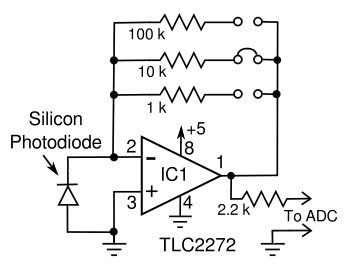
transimpedance amplifier circuit for a silicon photodiode.
Jumpers are used to select the gain, with the 100 k-ohm resistor providing the highest gain. For the eclipse measurements, the 10 k-ohm resistor was selected.
(Created using Inkscape.)
It would be somewhat hard to track the
Sun (I would use a
servomechanism), and not that worthwhile, because of the expected cloudy day. Instead, I built a
cowl for the photodiode that selected a small
solid angle of the
sky at
zenith for measurement (see figure). The solid angle was large enough to sample blue sky through occasional clouds, but not large enough to capture any direct
sunlight.
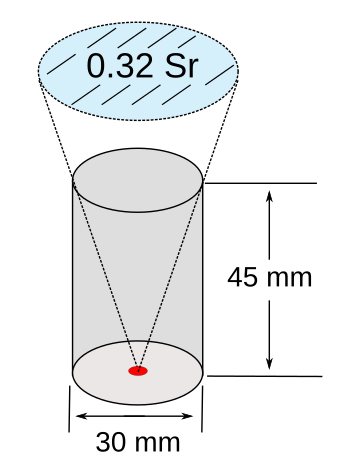
The cowl used for the photodiode.
This was fabricated from a black plastic 35 mm film cannister, which is an uncommon item, today, but ideal for this task.
(Created using Inkscape.)
To avoid early
morning and late
afternoon shadows from surrounding
trees, I placed the sensor module at the edge of my
roof, as shown in the photograph.
Data collection was through an
analog-to-digital converter that connected to a
USB port on my
laptop computer, conveniently located in a room underneath the sensor module. The connecting
cables were passed through an exterior door. I wrote the data collection
software using
Gambas, a
programming environment for
Linux not unlike
Visual Basic. Data points were taken at 10 second intervals.
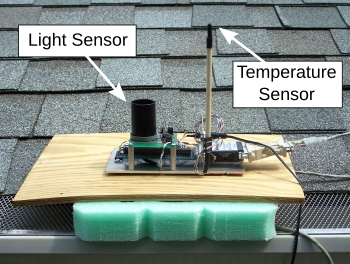
Eclipse sensor module in place at the edge of my roof.
The cables were routed through a sliding door beneath the sensor module location.
As expected, it was a cloudy day in
New Jersey, with the Sun appearing just occasionally through the clouds. Passage of clouds through the zenith was detected by the photometer, both on the day of the eclipse, and the previous day, which was used as an equipment check and an opportunity of log some
reference data. The reference data showed how the daytime light peaked at mid-day.
Sunrise wass at 6:15 AM EDT, and
sunset was at 7:45 PM EDT, so mid-day was about 1:00 PM.
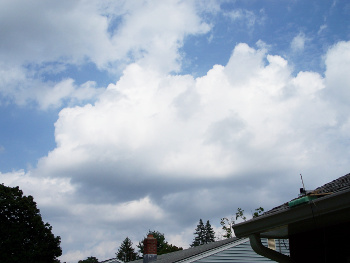
Not ideal eclipse weather.
This a view of the sky looking NNE at eclipse maximum occultation.
The clouds notwithstanding, there was a noticeable darkening at maximum occultation. As the data show, the lightness of the sky was equivalent to what's experienced early morning or late afternoon.
Since the
transient cloud cover added a lot chatter to the data, the data were
post-processed using a ten minute
moving average to give the
graphs shown below. The dip in light intensity is easily seen when compared with the previous day's data. Also noted was a 3
°C cooling of the air temperature.
![]()
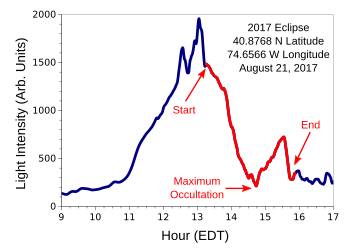
Light intensity throughout the day, Monday, August 21, 2017.
The partial eclipse is evident, with minimum light at the predicted time of maximum occultation.
(Graphed using Gnumeric. Click for larger image.)
![]()
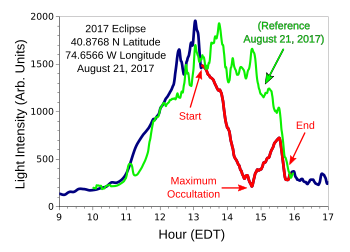
Light intensity throughout the day, Monday, August 21, 2017, including reference data from the day before.
The percentage drop in light intensity from the partial eclipse is what was expected, with allowance for error arising from cloud cover.
(Graphed using Gnumeric. Click for larger image.)
![]()
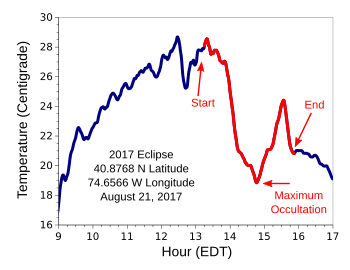
Cooling from the partial eclipse.
The solar irradiance in New Jersey can be as high as nearly a kilowatt per square meter.[1] Loss of all that energy results in significant cooling.
(Graphed using Gnumeric. Click for larger image.)
We should include at least one eclipse photo (below), and there are many others available on the Internet. Also on the Internet is a
YouTube video of a
satellite observation of the eclipse as it passed from the
West Coast to the
East Coast of the
United States.[2]
.jpg)
A composite image of the partial solar eclipse over Ross Lake, North Cascades National Park, Washington State, August 21, 2017. (NASA image by Bill Ingalls. For more images, see this NASA Website.[3])
References:
- NJ Statewide Solar Radiation (Daily Max), New Jersey Weather and Climate Network.
- Watch the Moon's Shadow Move from Coast to Coast, YouTube video of NOAA Satellite observations from 12:27 PM EDT through at 2:52 PM EDT, August 21, 2017.
- Total Solar Ecipse, August 21, 2017, NASA website.
Linked Keywords: Solar eclipse; Canada; Maine; occultation; childhood; North Latitude; West Longitude; total solar eclipse; recent eclipse of August 21, 2017; science; scientific; measurement; New York City; telescope; photograph; Internet; photometry; photometric; temperature; cloud; cloudy; computer; sensor; industrial design; module; photometer; thermometer; integrated circuit; temperature sensor; electronic circuit; Inkscape; silicon; photodiode; transimpedance amplifier circuit; gain; Sun; servomechanism; cowl; solid angle; sky; zenith; sunlight; plastic; 35 mm film cannister; morning; afternoon; shadow; tree; roof; data; analog-to-digital converter; USB port; laptop computer; cable; software; Gambas; programming environment; Linux; Visual Basic; sliding door; New Jersey; reference; sunrise; sunset; points of the compass; NNE; transient; low-pass filter; post-process; moving average; Cartesian coordinate system; graph; Celsius; °C; partial eclipse; occultation; Gnumeric; solar irradiance; kilowatt; square meter; energy; YouTube; video; satellite; West Coast; East Coast; United States; Ross Lake; North Cascades National Park; Washington State; Bill Ingalls.